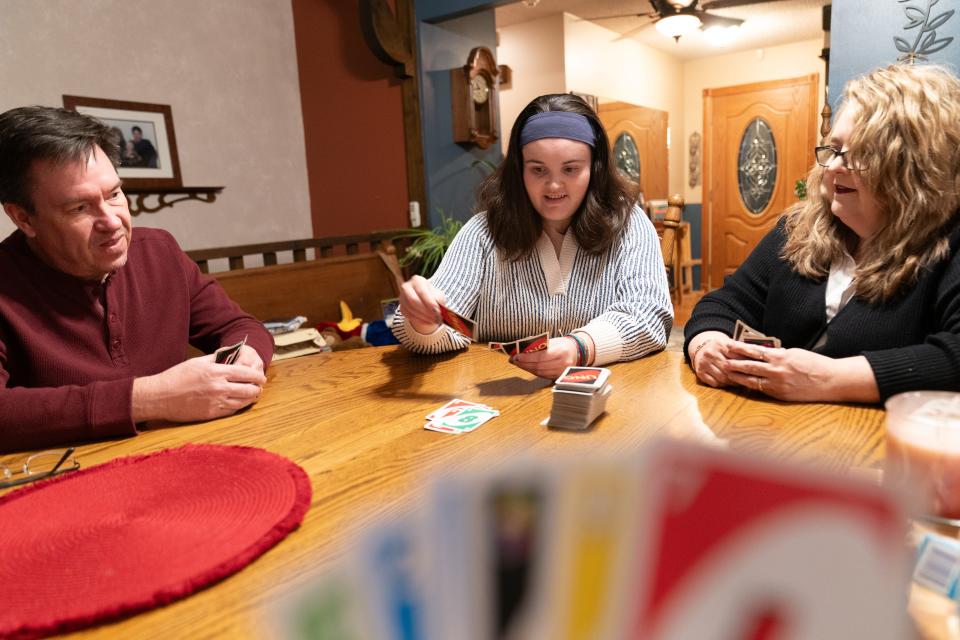Why Kansans are waiting a decade-plus for aid for developmentally disabled family members
Rick Elskamp’s daughter Sheridan was officially removed in December from the Intellectual and Developmental Disability Waitlist, a ledger of applicants seeking Medicaid-reimbursed support services.
It’s welcome news for Elskamp, who has been paying for the 23-year-old’s daycare service for the past year out of pocket. The total cost without a waiver is upward of $20,000 a year, a price Elskamp didn’t have to fully pay thanks to the service providers willing to negotiate a lower rate due to the lack of outside funding.
Though still not given resources promised to accepted I/DD voucher-holders, Elskamp’s time on the waitlist is almost over. But its difficult financial impact and rearranging of the family’s work life could have been much harsher if they didn’t have the foresight to apply for the program more than 10 years ago.
“It’s worked out as best as it could," Elskamp said. "But still, the whole system, we found out how bad it has gotten, how much it has failed us, how much it continues to fail families that are on the waitlist.”

To have gotten services at the time they did, they had to apply when Sheridan was 12 years old. Had a middle school special education teacher not raised the issue, it may have gone unnoticed and Sheridan denied services even longer. When finding day services for Sheridan, Elskamp and his wife had difficult decisions to make between costly day service or staying at home with their daughter.
“It was either ($20,000 a year day service) or one of us were going to have to either cut back or quit our job to stay with her because we really had no other options,” Elskamp said.
Sheridan was just one of 5,187 people in Kansas who were awaiting an I/DD waiver as of December.
What is Kansas waiting for?
Kansas is obligated to serve around 9,100 people through an I/DD Waiver. Once that obligation is met, the state can start a waitlist. Waivers cover a range of assistive services from such simple things as a medical-alert rental to more comprehensive supports, such as in-home care.
The waiver’s recipients are evaluated by a one of 27 Kansas regional community developmental disability organizations, which determine a person’s eligibility for services and works with families on what programs they can use.

The I/DD waitlist is part of the broader Home and Community Based Service waivers, which includes seven different waiver programs aimed at addressing physical and intellectual disabilities, youth mental health and medical challenges for the elderly.
It rose to prominence during the deinstitutionalization of America’s mental health care systems, where patients moved from psychiatric hospitals toward home-based care. Until the late 1990s, Kansas managed to keep the list comparatively low, but the list has grown steadily over the past two decades.
Rocky Nichols, executive director of Disability Rights Center of Kansas, said the cause of the backlog is simply because there hasn’t been an increase in funding to see more than 9,100 people. Over the past few years, investments into this program have largely gone to increase funding to the service providers who are contracted through HCBS.
“They’ve gotten a 45% to 46% or greater increase in the rate that providers get, and that has made slots more expensive because for every slot you’re going to fund, providers are getting more,” Nichols said.
Nichols said increasing the money home-based care professionals make — which has historically been low-paying and demanding work — is good. The problem lies, he said, in funding an increase for one side of the equation without addressing the growing waitlists.
“I think we’re in a good spot now that provider rates have been increased so much that we can reduce the waiting list and fund the slots,” Nichols said. “But even when provider rates were depressed, and were frankly too low, we still had a smaller waiting list. Why? Because we funded slots.”
There’s still a lot unknown about what will happen as the waiting list shrinks. It’s not even clear that, given the time people spend waiting for care, that they’ll still need it.
A presentation on the findings of an ongoing study from the University of Kansas’s Center on Developmental Disabilities found that only half the people who were removed from the I/DD Waitlist between 2017-2022 due to gaining a service waiver. The other half were either lost (13%), on the wrong list (9%), moved (7%), removed themselves (5%), no longer qualify (4%), joined a permanent nursing facility (4%), became financially ineligible (2%), died (2%) or no longer met the program’s eligibility criteria (2%).
There’s also the question of how able the current workforce would be to handle an influx of more than 5,000 patients. A survey is still ongoing but plans to assess the needed services and financial and employment impact of caregivers.
What's next at the Kansas Statehouse
Nichols criticized Gov. Laura Kelly’s lack of substantial investments into increasing costs in the IDD waitlist. A spreadsheet circulated by his organization shows the governor hasn’t proposed investments into the waitlist, and the Legislature has only added $3 million to the program since 2017.
Kelly has signed budgets that greatly increase the amount of money going toward rates for workers in HCBS programs, but the amount of money is often dwarfed by what’s approved in the Legislature.
“It has typically been the Legislature who steps up,” Nichols said. “The governors propose some increases here and there, but the Legislature introduces more.”
A spokesperson for Kelly said that the governor has invested $90 million in state funds into the I/DD waivers to reduce wait times, including $8.6 million investment in HCBS services this year. It also said workforce development must be a precursor to shrinking the growing list.

“The most important thing Kansas can do to recruit and retain the workforce needed to address the growing I/DD waiver wait list is to expand Medicaid. Governor Kelly will continue to push for Medicaid expansion to ensure the 15,000 Kansans with disabilities who would be eligible for coverage under expansion can get essential care and services,” Grace Hoge, communications coordinator for the governor's office, wrote in an email.
Expansion, one of Kelly’s top priorities this year, has been picked at by Republican leaders, who have priorities in health care of their own this session. After the governor’s State of the State speech, House Speaker Dan Hawkins, R-Wichita, listed increased Medicaid reimbursement rates, support of Federally Qualified Health Centers and funding HCBS waitlist programs as his priorities.
“The current wait for the IDD waiver waitlist is now up to about 11 years. That’s not OK," Hawkins’ spokesperson said in response to written questions. "We must care for our most vulnerable Kansans and make sure they can access the services that they need. That’s why Republicans will be addressing the IDD waiver waitlist during budget negotiations."
There’s no precise dollar figure on reducing the waitlist available. A rough estimate thrown out by the Kansas Legislative Research Department in a 2022 Special Committee on I/DD Waivers estimated around $200 million. However, KLRD noted that the workforce isn't large enough to care for 5,000 more patients.
This article originally appeared on Topeka Capital-Journal: More than 5,000 Kansans stuck on intellectual disability waiver backlog

